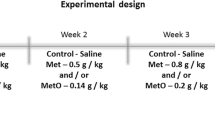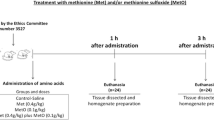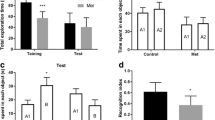Abstract
The aim of this study was to investigate the effect of the chronic administration of methionine (Met) and/or its metabolite, methionine sulfoxide (MetO), on the behavior and neurochemical parameters of young rats. Rats were treated with saline (control), Met (0.2–0.4 g/kg), MetO (0.05–0.1 g/kg), and/or a combination of Met + MetO, subcutaneously twice a day from postnatal day 6 (P6) to P28. The results showed that Met, MetO, and Met + MetO impaired short-term and spatial memories (P < 0.05), reduced rearing and grooming (P < 0.05), but did not alter locomotor activity (P > 0.05). Acetylcholinesterase activity was increased in the cerebral cortex, hippocampus, and striatum following Met and/or MetO (P < 0.05) treatment, while Na+, K+-ATPase activity was reduced in the hippocampus (P < 0.05). There was an increase in the level of thiobarbituric acid reactive substances (TBARS) in the cerebral cortex in Met-, MetO-, and Met + MetO-treated rats (P < 0.05). Met and/or MetO treatment reduced superoxide dismutase, catalase, and glutathione peroxidase activity, total thiol content, and nitrite levels, and increased reactive oxygen species and TBARS levels in the hippocampus and striatum (P < 0.05). Hippocampal brain-derived neurotrophic factor was reduced by MetO and Met + MetO compared with the control group. The number of NeuN-positive cells was decreased in the CA3 in Met + MetO group and in the dentate gyrus in the Met, MetO, and Met + MetO groups compared to control group (P < 0.05). Taken together, these findings further increase our understanding of changes in the brain in hypermethioninemia by elucidating behavioral alterations, biological mechanisms, and the vulnerability of brain function to high concentrations of Met and MetO.







Similar content being viewed by others
References
Aebi H (1984) Catalase in vitro. Methods Enzymol 105:121–126
Aksenov MY, Markesbery WR (2001) Changes in thiol content and expression of glutathione redox system genes in the hippocampus and cerebellum in Alzheimer’s disease. Neurosci Lett 302:141–145. https://doi.org/10.1016/S0304-3940(01)01636-6
Albouy G, King BR, Maquet P, Doyon J (2013) Hippocampus and striatum: dynamics and interaction during acquisition and sleep-related motor sequence memory consolidation. Hippocampus 23:985–1004. https://doi.org/10.1002/hipo.22183
Ali SF, LeBel CP, Bondy SC (1992) Reactive oxygen species formation as a biomarker of methylmercury and trimethyltin neurotoxicity. Neurotoxicology 13:637–648
Antunes M, Biala G (2012) The novel object recognition memory: neurobiology, test procedure, and its modifications. Cogn Process 13:93–110. https://doi.org/10.1007/s10339-011-0430-z
Bast T, Wilson IA, Witter MP, Morris RG (2009) From rapid place learning to behavioral performance: a key role for the intermediate hippocampus. PLoS Biol 7:e1000089. https://doi.org/10.1371/journal.pbio.1000089
Belzung C, Griebel G (2001) Measuring normal and pathological anxiety-like behaviour in mice: a review. Behav Brain Res 125:141–149. https://doi.org/10.1016/S0166-4328(01)00291-1
Bohnen NI, Albin R (2010) The cholinergic system and Parkinson disease. Behav Brain Res 22:564–573. https://doi.org/10.1016/j.bbr.2009.12.048
Borta A, Schwarting RKW (2005) Post-trial treatment with the nicotinic agonist metanicotine: differential effects in Wistar rats with high versus low rearing activity. Pharmacol Biochem Behav 80:541–548. https://doi.org/10.1016/j.pbb.2004.12.014
Bradford M (1976) A rapid and sensitive method for the quantitation of microgram quantities of protein utilizing the principle of protein–dye binding. Anal Biochem 72:248–254. https://doi.org/10.1016/0003-2697(76)90527-3
Carrasco M, Rabaneda LG, Murillo-Carretero M, Ortega-Martínez S, Martínez-Chantar ML, Woodhoo A, Luka Z, Wagner C, Lu SC, Mato JM, Micó JA, Castro C (2014) Glycine N-methyltransferase expression in the hippocampus and its role in neurogenesis and cognitive performance. Hippocampus 24:840–852. https://doi.org/10.1002/hipo.22274
Chamberlin ME, Ubagai T, Mudd SH, Wilson WG, Leonard JV, Chou JY (1996) Demyelination of the brain is associated with methionine adenosyltransferase I/III deficiency. J Clin Invest 98:1021–1027. https://doi.org/10.1172/JCI118862
Chan K, Delfert D, Junger KD (1986) A direct colorimetric assay for Ca2+-ATPase activity. Anal Biochem 157:1375–1378. https://doi.org/10.1016/0003-2697(86)90640-8
Clausen MV, Hilbers F, Poulsen H (2017) The structure and function of the Na, K-ATPase Isoforms in health and disease. Front Physiol 8:371. https://doi.org/10.3389/fphys.2017.00371
Costa MZ, Silva TM, Flores NP, Schmitz F, Scherer EBS, Viau CM, Saffi J, Barschak AG, Wyse AT, Spanevello RM, Stefanello FM (2013) Methionine and methionine sulfoxide alter parameters of oxidative stress in the liver of young rats: in vitro and in vivo studies. Mol Cell Biochem 384:21–28. https://doi.org/10.1007/s11010-013-1777-5
Couce ML, Bóveda MD, Castiñeiras DE, Corrales FJ, Mora MI, Fraga JM, Mudd SH (2008) Hypermethioninaemia due to methionine adenosyltransferase I/III (MAT I/III) deficiency: diagnosis in an expanded neonatal screening programme. J Inherit Metab Dis 2:S233–S239. https://doi.org/10.1007/s10545-008-0811-3
Dellu F, Fauchey V, LeMoal M, Simon H (1997) Extension of a new two-trial memory task in the rat: influence of environmental context on recognition processes. Neurobiol Learn Mem 67:112–120. https://doi.org/10.1006/nlme.1997.3746
Dos Santos LM, da Silva TM, Azambuja JH, Ramos PT, Oliveira PS, da Silveira EF, Pedra NS, Galdino K, Couto CA, Soares MS, Tavares RG, Spanevello RM, Stefanello FM, Braganhol E (2016) Methionine and methionine sulfoxide treatment induces M1/classical macrophage polarization and modulates oxidative stress and purinergic signaling parameters. Mol Cell Biochem 424:69–78. https://doi.org/10.1007/s11010-016-2843-6
Ellman GL, Courtney KD, Andres V, Featherstone RM (1961) A new and rapid colorimetric determination of acetylcholinesterase activity. Biochem Pharmacol 17:88–95. https://doi.org/10.1016/0006-2952(61)90145-9
Erasso DM, Camporesi EM, Mangar D, Saport S (2013) Effects of isoflurane or propofol on postnatal hippocampal neurogenesis in young and aged rats. Brain Res 1530:1–12. https://doi.org/10.1016/j.brainres.2013.07.035
Esterbauer H, Cheeseman KH (1990) Determination of aldehydic lipid peroxidation products: malonaldehyde and 4-hydroxynonenal. Methods Enzymol 186:407–421. https://doi.org/10.1016/0076-6879(90)86134-H
Ferreira-Vieira TH, Guimaraes IM, Silva FR, Ribeiro FM (2016) Alzheimer’s disease: targeting the cholinergic system. Curr Neuropharmacol 14:101–115. https://doi.org/10.2174/1570159X13666150716165726
Gahl WA, Bernardini I, Finkelstein JD, Tangerman A, Martin JJ, Blom HJ, Mullen KD, Mudd SH (1988) Transsulfuration in an adult with hepatic methionine adenosyltransferase deficiency. J Clin Invest 81:390–397. https://doi.org/10.1172/JCI113331
Gasparovic AC, Zarkovic N, Zarkovic K, Semen K, Kaminskyy D, Yelisyeyeva O, Bottari SP (2016) Biomarkers of oxidative and nitro-oxidative stress: conventional and novel approaches. Br J Pharmacol 174:1771–1783. https://doi.org/10.1111/bph.13673
Ghiglieri V, Sgobio C, Costa C, Picconi B, Calabresi P (2011) Striatum–hippocampus balance: from physiological behavior to interneuronal pathology. Prog Neurobiol 94:102–114. https://doi.org/10.1016/j.pneurobio.2011.04.005
Holm TH, JostIsaksen T, Glerup S, Heuck A, Bottger P, Füchtbauer E, Nedergaard S, Nyengaard JR, Andreasen M, Nissen P, Lykke-Hartmann K (2016) Cognitive deficits caused by a disease-mutation in the α3 Na+/K+-ATPase isoform. Sci Rep 6:31972. https://doi.org/10.1038/srep31972
Hrncic D, Mikić J, Rasic-Markovic A, Velimirović M, Stojković T, Obrenović R, Rankov-Petrović B, Šušić V, Djuric D, Petronijević N, Stanojlovic O (2016) Anxiety-related behavior in hyperhomocysteinemia induced by methionine nutritional overload in rats: role of the brain oxidative stress. Can J Physiol Pharmacol 94:1074–1082. https://doi.org/10.1139/cjpp-2015-0581
Huang T, Leu D, Zou Y (2015) Oxidative stress and redox regulation on hippocampal-dependent cognitive functions. Arch Biochem Biophys 576:2–7. https://doi.org/10.1016/j.abb.2015.03.014
Huf F, Bandiera S, Müller CB, Gea L, Carvalho FB, Rahmeier FL, Reiter KC, Tortorelli LS, Gomez R, Fernandes MC (2018) Comparative study on the effects of cigarette smoke exposure, ethanol consumption and association: behavioral parameters, apoptosis, glial fibrillary acid protein and S100β immunoreactivity in different regions of the rat hippocampus. Alcohol. https://doi.org/10.1016/j.alcohol.2018.08.009
Leal G, Comprido D, Duarte CB (2014) BDNF-induced local protein synthesis and synaptic plasticity. Neuropharmacology 76:639–656. https://doi.org/10.1016/j.neuropharm.2013.04.005
Leal G, Afonso PM, Salazar IL, Duarte CB (2015) Regulation of hippocampal synaptic plasticity by BDNF. Brain Res 1621:82–101. https://doi.org/10.1016/j.brainres.2014.10.019
Lowry OH, Rosebrough NJ, Farr AL, Randall RJ (1951) Protein measurement with the Folin phenol reagent. J Biol Chem 193:265–275
Marcão A, Couce ML, Nogueira C, Fonseca H, Ferreira F, Fraga JM, Bóveda MD, Vilarinho L (2015) Newborn screening for homocystinuria revealed a high frequency of MATI/III deficiency in Iberian Peninsula. JIMD Rep 20:113–120. https://doi.org/10.1007/8904_2014_400
Misra HP, Fridovich I (1972) The role of superoxide anion in the autoxidation of epinephrine and a simple assay for superoxide dismutase. J Biol Chem 247:3170–3175
Moseley AE, Williams MT, Schaefer TL, Bohana CS, Neumann JC, Behbehani MM, Vorhees CV, Lingrel JB (2007) Deficiency in Na, K-ATPase alpha isoform genes alters spatial learning, motor activity, and anxiety in mice. J Neurosci 27:616–626. https://doi.org/10.1523/JNEUROSCI.4464-06.2007
Mudd SH (2011) Hypermethioninemias of genetic and non-genetic origin: a review. Am J Med Genet Part C 157:3–32. https://doi.org/10.1002/ajmg.c.30293. (Seminars in Medical Genetics)
Mudd SH, Jenden DJ, Capdevila A, Roch M, Levy HL, Wagner C (2000) Isolated hypermethioninemia: measurements of S-adenosylmethionine and choline. Metabolism 49:1542–1547. https://doi.org/10.1053/meta.2000.18521
Mudd SH, Mudd SH, Skovby F (2001) Disorders of transsulfuration. In: Scriver CR, Beaudet AL, Sly WS, Valle D (eds) The metabolic and molecular bases of inherited disease. McGraw-Hill, New York, pp 1279–1327
Nashabat M, Al-Khenaizan S, Alfadhel M (2018) Methionine adenosyltransferase I/III deficiency: beyond the central nervous system manifestations. Ther Clin Risk Manag 14:225–229. https://doi.org/10.2147/TCRM.S151732
Patel M (2016) Targeting oxidative stress in central nervous system disorders. Trends Pharmacol Sci 37:768–778. https://doi.org/10.1016/j.tips.2016.06.007
Paul V, Ekambaram P (2011) Involvement of nitric oxide in learning and memory processes. Indian J Med Res 133:471–478
Pawlak CR, Schwarting RKW (2002) Object preference and nicotine consumption in rats with high vs. low rearing activity in a novel open field. Pharmacol Biochem Behav 73:679–687. https://doi.org/10.1016/S0091-3057(02)00852-3
Rahmeier FL, Zavalhia LS, Tortorelli LS, Huf F, Géa LP, Meurer RT, Machado AC, Gomez R, Fernandes MDC (2016) The effect of taurine and enriched environment on behaviour, memory and hippocampus of diabetic rats. Neurosci Lett 630:84–92. https://doi.org/10.1016/j.neulet.2016.07.032
Rossato JI, Bevilaqua LRM, Myskiw JC, Medina JH, Izquierdo I, Cammarota M (2007) On the role of hippocampal protein synthesis in the consolidation and reconsolidation of object recognition memory. Learn Mem 14:36–46. https://doi.org/10.1101/lm.422607
Roy R, Niccolini F, Pagano G, Politis M (2016) Cholinergic imaging in dementia spectrum disorders. Eur J Nucl Med Mol Imaging 43:1376–1386. https://doi.org/10.1007/s00259-016-3349-x
Schweinberger BM, Wyse AT (2016) Mechanistic basis of hypermethioninemia. Amino Acids 48:2479–2489. https://doi.org/10.1007/s00726-016-2302-4
Schweinberger BM, Turcatel E, Rodrigues AF, Wyse ATS (2015) Gestational hypermethioninaemia alters oxidative/nitrative status in skeletal muscle and biomarkers of muscular injury and inflammation in serum of rat offspring. Int J Exp Pathol 96:277–284. https://doi.org/10.1111/iep.12136
Schweinberger BM, Rodrigues AF, Dos Santos TM, Rohden F, Barbosa S, da Luz Soster PR, Partata WA, Faccioni-Heuser MC, Wyse ATS (2018a) Methionine administration in pregnant rats causes memory deficit in the offspring and alters ultrastructure in brain tissue. Neurotox Res 33:239–246. https://doi.org/10.1007/s12640-017-9830-x
Schweinberger BM, Rodrigues AF, Turcatel E, Pierozan P, Pettenuzzo LF, Grings M, Scaini G, Parisi MM, Leipnitz G, Streck EL, Barbé-Tuana FM, Wyse ATS (2018b) Maternal hypermethioninemia affects neurons number, neurotrophins levels, energy metabolism, and Na+, K+-atpase expression/content in brain of rat offspring. Mol Neurobiol 55:980–988. https://doi.org/10.1007/s12035-017-0383-z
Silhol M, Arancibia S, Maurice T, Tapia-Arancibia L (2007) Spatial memory training modifies the expression of brain-derived neurotrophic factor tyrosine kinase receptors in young and aged rats. Neuroscience 146:962–973. https://doi.org/10.1016/j.neuroscience.2007.02.013
Silman I, Sussman JL (2005) Acetylcholinesterase: ‘classical’ and ‘non-classical’ functions and pharmacology. Curr Opin Pharmacol 5:293–302. https://doi.org/10.1016/j.coph.2005.01.014
Soares MS, Oliveira PS, Debom GN, da Silveira Mattos B, Polachini CR, Baldissarelli J, Morsch VM, Schetinger MR, Tavares RG, Stefanello FM, Spanevello RM (2017a) Chronic administration of methionine and/or methionine sulfoxide alters oxidative stress parameters and ALA-D activity in liver and kidney of young rats. Amino Acids 49:129–138. https://doi.org/10.1007/s00726-016-2340-y
Soares MSP, Viau CM, Saffi J, Costa MZ, da Silva TM, Oliveira PS, Azambuja JH, Barschak AG, Braganhol E, Wyse AT, Spanevello RM, Stefanello FM (2017b) Acute administration of methionine and/or methionine sulfoxide impairs redox status and induces apoptosis in rat cerebral cortex. Metab Brain Dis 32:1693–1703. https://doi.org/10.1007/s11011-017-0054-9
Stefanello FM, Chiarani F, Kurek AG, Wannmacher CMD, Wajner M, Wyse AT (2005) Methionine alters Na+, K+-ATPase activity, lipid peroxidation and nonenzymatic antioxidant defenses in rat hippocampus. Int J Dev Neurosci 23:651–656. https://doi.org/10.1016/j.ijdevneu.2005.06.003
Stefanello FM, Matté C, Scherer EB, Wannmacher CMD, Wajner M, Wyse ATS (2007a) Chemically induced model of hypermethioninemia in rats. J Neurosci Methods 160:1–4. https://doi.org/10.1016/j.jneumeth.2006.07.029
Stefanello FM, Monteiro SC, Matté C, Scherer EB, Netto CA, Wyse AT (2007b) Hypermethioninemia increases cerebral acetylcholinesterase activity and impairs memory in rats. Neurochem Res 32:1868–1874. https://doi.org/10.1007/s11064-007-9464-0
Stefanello FM, Matté C, Pederzolli CD, Kolling J, Mescka CP, Lamers ML, Assis AM, Perry ML, Santos MF, Dutra-Filho CS, Wyse ATS (2009) Hypermethioninemia provokes oxidative damage and histological changes in liver of rats. Biochimie 91:961–968. https://doi.org/10.1016/j.biochi.2009.04.018
Stefanello FM, Ferreira AG, Pereira TC, da Cunha MJ, Bonan CD, Bogo MR, Wyse AT (2011) Acute and chronic hypermethioninemia alter Na+, K+-ATPase activity in rat hippocampus: prevention by antioxidants. Int J Dev Neurosci 29:483–488. https://doi.org/10.1016/j.ijdevneu.2011.02.001
Stuehr DJ, Nathan CF (1989) Nitric oxide. A macrophage product responsible for cytostasis and respiratory inhibition in tumor target cells. J Exp Med 169:1543–1555. https://doi.org/10.1084/jem.169.5.1543
Suzuki S, Kodera Y, Saito T, Fujimoto K, Momozono A, Hayashi A, Kamata Y, Shichiri M (2016) Methionine sulfoxides in serum proteins as potential clinical biomarkers of oxidative stress. Sci Rep 6:38299. https://doi.org/10.1038/srep38299
Tarrago L, Péterfi Z, Lee BC, Michel T, Gladyshev VN (2015) Monitoring methionine sulfoxide with stereospecific mechanism-based fluorescent sensors. Nat Chem Biol 11:332–338. https://doi.org/10.1038/nchembio.1787
Toda N, Okamura T (2016) Hyperhomocysteinemia impairs regional blood flow: involvements of endothelial and neuronal nitric oxide. Pflugers Arch 468:1517–1525. https://doi.org/10.1007/s00424-016-1849-y
Vann SD, Albasser MM (2011) Hippocampus and neocortex: recognition and spatial memory. Curr Opin Neurobiol 21:440–445. https://doi.org/10.1016/j.conb.2011.02.002
Vuaden FC, Savio LE, Piato AL, Pereira TC, Vianna MR, Bogo MR, Bonan CD, Wyse AT (2012) Long-term methionine exposure induces memory impairment on inhibitory avoidance task and alters acetylcholinesterase activity and expression in zebrafish (Danio rerio). Neurochem Res 37:1545–1553. https://doi.org/10.1007/s11064-012-0749-6
Wyse AT, Streck EL, Barros SV, Brusque AM, Zugno AI, Wajner M (2007) Methylmalonate administration decreases Na+, K+-ATPase activity in cerebral cortex of rats. NeuroReport 11:2331–2334. https://doi.org/10.1097/00001756-200007140-00052
Zhang L, Zhang Z, Guo H, Wang Y (2008) Na+/K+-ATPase-mediated signal transduction and Na+/K+-ATPase regulation. Fundam Clin Pharmacol 22:615–621. https://doi.org/10.1111/j.1472-8206.2008.00620.x
Acknowledgements
This research was supported by the Conselho Nacional de Desenvolvimento Científico e Tecnológico and Fundação de Amparo à Pesquisa do Rio Grande do Sul (FAPERGS). This study was financed in part by Coordenação de Aperfeiçoamento de Pessoal de Nível Superior—Brasil (CAPES)—Finance code 001.
Author information
Authors and Affiliations
Corresponding author
Ethics declarations
Conflict of interest
The authors declare that there are no conflicts of interest.
Additional information
Handling Editor: M. Engelmann.
Publisher's Note
Springer Nature remains neutral with regard to jurisdictional claims in published maps and institutional affiliations.
Rights and permissions
About this article
Cite this article
Soares, M.S.P., de Mattos, B.d.S., de Souza, A.Á. et al. Hypermethioninemia induces memory deficits and morphological changes in hippocampus of young rats: implications on pathogenesis. Amino Acids 52, 371–385 (2020). https://doi.org/10.1007/s00726-019-02814-2
Received:
Accepted:
Published:
Issue Date:
DOI: https://doi.org/10.1007/s00726-019-02814-2




